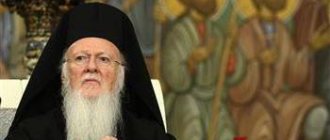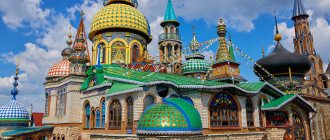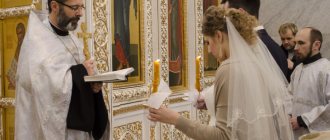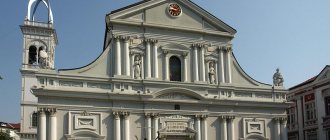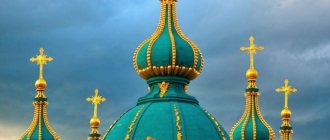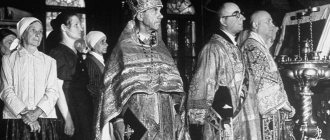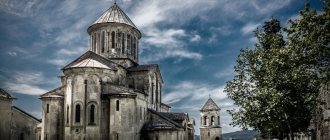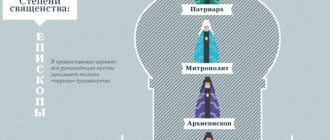Origin of the term
The word “katalikos” translated from Greek means “conciliar” or “universal”. It speaks of the spiritual unity of all Orthodox believers of Armenians. In the ancient church hierarchy, the Catholicos were the Primates of the Christian Churches, whose spiritual power extended to territories beyond the borders of the Byzantine Empire. Among the bearers of the title of Katalikos, established from past times, there are Georgian, Assyrian, Malankara, Ancient Church of the East, Abkhazian, Syro-Jacobite and Armenian first hierarchs.
Yandex pictures
The honorary title of Katalikos, the highest spiritual rank of the Armenian Church, was introduced in 363. This term was applied to many other representatives of the clergy (Armenian Bishop Eusephius of Caesarea). It was first mentioned in documents found in the Dvina Cathedral.
History of the AAC
The first preachers of Christianity in Armenia are considered to be the apostles Thaddeus and Bartholomew. The oldest mention of Christian preaching in Armenia dates back to the end. 2nd century Christianity penetrated here both through Syria and through Greek-speaking Cappadocia. Organization of the AAC as an official Armenian churches state is associated with the name of St. Gregory the Illuminator (after whom the AAC is sometimes called the Armenian-Gregorian). He converted King Trdat III to Christianity, founded the first churches and began the baptism of the people (between 284 and 314, traditional date - 301). The Etchmiadzin Cathedral was built in the capital of Great Armenia, Vagharshapat. Initially, the primates of the AAC (Catholicos) were ordained in Caesarea in Cappadocia, from the 2nd half. 4th century they were elected in Armenia itself. After the division of Greater Armenia between Byzantium and Iran (from the 7th century - the Caliphate), the Armenians and other Christian peoples of the Caucasus fought against the attempts of the Sassanids to impose Zoroastrianism. As a result of the anti-Persian uprisings (450–451, 482–484, 571–572), Christianity was recognized as a tradition. religion of Armenia; from that time on, the AAC remained the only institution that united the entire Armenian army. people. In the beginning. 5th century Mesrop Mashtots created Armenian. alphabet and, together with Catholicos Sahak, translated the Bible into Armenian. language. Writers, translators and copyists of books were usually persons of clergy rank. Monasteries became centers of culture and education, which, under the conditions of centuries-old foreign rule, preserved and multiplied the cultural heritage.
Archive of the “Orthodox Encyclopedia” Temple complex Akhtamar. Church of the Holy Cross (915–921) (in modern Turkey). Architect Manuel.
From the end 5th century The throne of the Catholicos was in the city of Dvin. In the 10th–12th centuries. Catholicoses lived in different cities and regions. In 1114 ep. Akhtamarsky proclaimed himself patriarch and Catholicos, refusing to recognize the Catholicos in Ani; after reconciliation with the AAC (beginning of the 15th century), the department of Akhtamar retained the title of Catholicosate. Mass resettlement of Armenians to the west. and south regions of Asia Minor, caused by the invasion of the Seljuks, was accompanied by the movement of the residence of the primate of the AAC to Sis, the capital of Cilician Armenia (1293). In connection with the receipt of the book. Levon received the royal title from the pope (1198) and negotiated a union with the Catholics. Some of the hierarchs entered into communication with Rome. church, but at the Council of Sis (1361) lat. innovations were canceled. After the conquest of Cilicia by the Mamluks, ch. the throne of the AAC was returned to its ancient center - Etchmiadzin (1441); Cilician bishops retained the title of Catholicos and for a long time did not recognize the primacy of Etchmiadzin. From 15 to midday 17th centuries in the Etchmiadzin Catholicosate there was an institution of “triple primacy” (the Catholicos and his two deputies). After the fall of Constantinople, which became the capital of the Ottoman Empire, the Armenian Patriarchate was formed here (1461); its primate was recognized as a religionist. and adm. the head of the “Armenian millet,” which, in addition to Armenians, also included communities of other faiths (Jacovites, Maronites, Bogomils and Catholics). In 1651, reconciliation took place between the Etchmiadzin and Cilician Catholicosates, which formed a single hierarchy. In Russia, Armenian dioceses were formed in Astrakhan (1717) and Bessarabia (1809). In 1828 East. Armenia and Etchmiadzin became part of Russia. empires. Soon the Novonakhichevan-Bessarabian diocese was formed with its center in Chisinau (1830; in 1858–79 the bishop's residence was in Feodosia). The activities of the AAC on its territory proceeded in accordance with the “Regulations” approved by the imp. Nicholas I (1836). In the Ottoman Empire, according to Nat. constitutions 1860–63, spiritual and civil. arm. control The population was under the authority of two councils: spiritual (chaired by the Patriarch of Constantinople) and secular. During the 1st World War, the AAC in Turkey suffered losses along with the entire Armenian army. population; most of the dioceses of the Patriarchate of Constantinople and the Akhtamar Catholicosate ceased to exist; the Cilician throne was revived in the 1930s. in mon. Antillas near Beirut. With the approval of the owls. authorities in Transcaucasia (1920), the scope of activity of the Etchmiadzin Catholicosate was sharply reduced, and anti-religion developed in Armenia. propaganda. In 1945, with the permission of the Soviets. authorities in Armenia, the National Church Council of the Armenian Apostolic Church was held for the first time. The repatriation of Armenians to the USSR that began after World War II also had a positive impact on strengthening the positions of the AAC. After the proclamation of the independent Republic of Armenia, the role of the church in cultural life increased even more.
Cover of the handwritten Gospel. 1374. Golden pantry of the Etchmiadzin Catholicosate. Archive of the "Orthodox Encyclopedia"
The creed of the AAC is based on the recognition of the first three Ecumenical Councils. The dogma of the Council of Chalcedon about two natures in Christ was rejected at the Council of Dvina (554/555). In the 7th century. During negotiations with Constantinople, the so-called Karin Union, however, at the Manazkert Council (726) the AAC proclaimed the doctrine of the one (Divine) nature of Christ.
Catholicos are anointed several times. (from 3 to 12) by bishops. Only they have the right to cook and bless St. chrism, ordain bishops, approve new church laws and resolve issues of church government. The ritual customs of the AAC go back to the ancient Eastern Christian tradition and are close to the Orthodox. Among the features: the feast of Epiphany on January 6, which combines the Nativity of Christ and Epiphany; the use of unleavened bread and undiluted wine in the sacrament of the Eucharist; sign of the cross with 3 fingers from left to right; Advance post (Arajavorats) 3 weeks before Lent; charitable animal sacrifice (matah) on major holidays. The service is conducted in Old Armenian. language (grabar). In 1924, the AAC switched to a new calendar style.
Gospel. 1484. Paper. Scripter Priest Azaria, artist Kirakos. Archive of the "Orthodox Encyclopedia"
Initially, the service was conducted in Greek. and sire. languages, prayers and psalms were sung in Armenian. language. From the 5th century after translating the Bible and liturgical texts into Armenian. language – Armenian becomes the language of worship. The oldest type of chants, which arose immediately after the invention of Armenian. writing - ktsurd (close to the Byzantine troparion, Syrian madrash). The authors of the first ktsurds were Mesrop Mashtots, Sahak Partev, Movses Khorenatsi and others. From the end. 6 – beginning 7th centuries The katsurd (kontakion) genre was developed in the 8th century. Byzantium was adopted. genre canon. By the 9th century The ktsurds developed into independent ones. hymns (authors – Anania Shirakatsi and others), in the 12th century. called sharakans. In the 12th–15th centuries. A song book was formed - Sharaknots (Hymnarium), the basis for which was a set of hymns compiled in the 7th century. Barsekh Tchon. Means. The role in the formation of Sharaknots and Patarag (Liturgy) belongs to Nerses Shnorali (12th century). The basis of Armenian Church monody is made up of a system of voices (Stepanos Syunetsi in the 8th century systematized spiritual hymns according to the voice principle). For recording chants from the 9th century. the original non-neutral, or Khaz, notation was used (see Khazy). In the 19th–20th centuries. the so-called New Armenian notation is a non-linear notation with precise indications of pitch and rhythm (created in the early 19th century by A. Limonjian). In the 2nd half. 19th century Polyphony entered the divine service (for the first time in the work of Komitas). Since the 19th century 3 main ones were officially adopted. singing books: Sharaknots, Patarag, Zhamagirk (Book of Hours), compiled by N. Tashchyan. In modern In the church, the daily service is accompanied by sharakans (there are 2000 of them), on Sundays the Patarag is performed [including the Patarag of Komitas (completed by his student V. Sargsyan) and M. Ekmalyan (published in 1892)].
Election procedure
The spiritual leader of the Armenian people is elected by members of the National Church Assembly (consists of several dioceses and communities of the AAC, uniting Orthodox Christians from among Armenians around the world) for a life term. Usually the highest title of the Armenian Church is given to one of the bishops. How does the election process work:
- A secret vote is held, as a result of which five bishops suitable for the role of Catholicos are selected.
- Of the five applicants, only one is chosen and becomes the Catalicos.
The person elected to the position of Supreme Patriarch is anointed by five bishops.
AAC at the turn of the 20th–21st centuries
The highest body of the AAC is the Church-National. a cathedral of clergy and secular persons. At the Council, the head of the Armenian Apostolic Church is elected, who is the Supreme Patriarch and Catholicos of all Armenians with the throne in Etchmiadzin (since 1999 - Karekin II). In the jurisdiction of the Etchmiadzin Catholicosate there are 8 episcopal sees in Armenia and approx. 20 beyond. In 1966, a single Novonakhichevan and Russian diocese of the AAC was formed with its center in Moscow; in 1997, the dioceses of the South of Russia, with a center in Krasnodar, and Ukraine, with a center in Lvov, were separated from it. To the number of ch. The thrones of the AAC include the Cilician Catholicosate (in Antillas, Lebanon), whose dioceses are located in Lebanon, Syria and some other countries, as well as the Jerusalem and Istanbul Armenian Patriarchates, which do not have dioceses and are under the spiritual guidance of the Supreme Catholicos. The dioceses and parishes of the AAC are scattered across 5 continents of the world and unite approx. 6 million believers. With all 4 ch. Theological educational institutions operate on the thrones of the AAC, and printed publications are published.
Symbols of power
Katalikos is the abbreviated name for the position of the supreme person of the Armenian Apostolic Church. In pastoral letters and other official religious documents, the title has a detailed spelling: “Garekin II, servant of Jesus Christ, by the grace of God and the will of the people, High Hierarch and Catholicos of all Armenians, Supreme Patriarch of the nationally venerable Ararat Throne of the Apostolic Church of the Mother See of the Holy Cathedral Etchmiadzin.”
Yandex. Images
The status of His Holiness the Supreme Patriarch and Catholicos of all Armenians is confirmed by distinctive symbols. They are expressed in his expensive church attire. Insignia marking the highest rank of spiritual leader:
- coat of arms of the Armenian Apostolic Church (yellow emblem on a purple background);
- personal seal of the Catholicos;
- a veil with the image of God's Lamb (placed on the head);
- throne of the Supreme Patriarch;
- large and small bishop's staffs;
- conker club;
- gold patriarchal cross inlaid with precious stones.
At the head of all laity and clergy belonging to the AAC is the Catholicos of All Armenians or the Supreme Patriarch of the Apostolic Church of Armenia. This term was taken from the Greek language, its meaning indicates the unity of all representatives of the dioceses and communities of the AAP. In the past, the title of “catalicos” was borne by the primates of the Churches in the Middle East (Georgian, Assyrian, Malankara, Syro-Jacobite). The bearer of the title is chosen by secret ballot from five bishops and undergoes the church ritual of anointing. The high position of the first hierarch is indicated by official symbols: a golden cross, a Latin staff, a veil, a seal, a throne.
